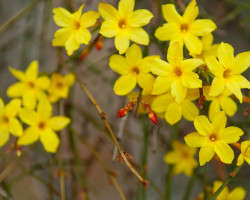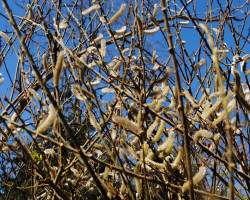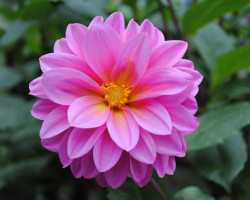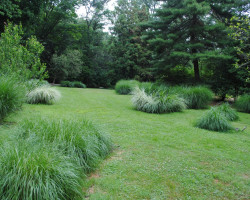October
March
April
May
June
July
August
Sept
October
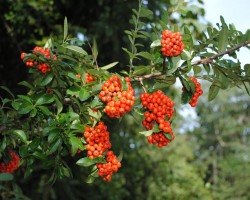
Firehorn
Firethorn (Pyracanthus) is a genus of large, thorny evergreen shrubs in the family Rosaceae, with common names firethorn or pyracantha. They are native to an area extending from southwest Europe east to southeast Asia. They resemble and are related to Cotoneaster, but have serrated leaf margins and numerous thorns. Pyracantha prefers full sun to partial shade and well-drained soil. Planting in highly fertile soil will produce rampant growth, which makes the plant more susceptible to fire blight and decreases berry production. It is best to plant pyracantha bushes in the fall.
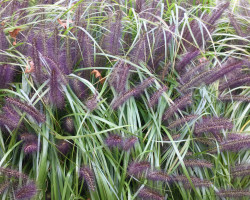
Fountain grass “Moudry”
Fountain grass “Moudry” (Pennisetum Alopecuroides), known also as the Chinese pennisetum, Chinese fountain grass, dwarf fountain grass, foxtail fountain grass, or swamp foxtail grass, is a species of perennial grass native to Asia and Australia. It is a warm season ornamental grass which typically grows in graceful, spreading clumps from 2 feet to 3 feet tall and as wide. Fountain grass features narrow, medium-to-deep-green leaves in summer that fade to beige in late fall. Foliage usually remains attractive throughout the winter. This grass has deep purple bottlebrush plumes with black overtones, rising from the foliage in early fall, like water spraying from a fountain (hence the common name). The genus name comes from the Latin penna meaning “feather” and seta meaning “bristle” in reference to the flowers having long, feathery bristles.
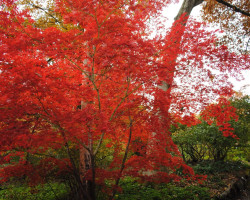
Japanese maple “Fireglow”
Japanese maple “Fireglow” (Acer palmatum) are prized as ornamental trees for their beautiful perennial red leaves. Fireglow is an excellent red upright maple tree that reaches 10 feet to 12 feet in15 years. Fireglow leafs out as bright red, before maturing to a deep maroon for the summer. It will get an orange-red glow to the back side of the leaf when grown in the sun, giving the tree a brighter appearance and making it glow when looked at from below. Fireglow turns to a brighter fiery red in the fall.
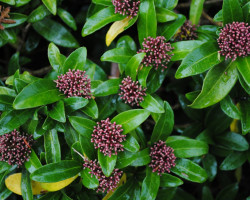
Japanese Skimmia
Japanese Skimmia (Skimmia japonica) is a shade-loving evergreen shrub that adds color to the garden nearly all year round. Skimmia is at its best in semi-shady, woodland gardens. It is relatively deer-resistant, and the berries are very attractive to hungry songbirds. Japanese Skimmia welcomes spring with reddish-pink buds, which soon burst into masses of tiny, creamy white summertime blooms. If a male plant is nearby for pollination, female plants light up the landscape with bright red berries in fall and winter.
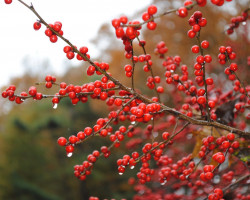
Winterberry
Winterberry (Ilex verticillata) is a deciduous holly native to eastern North America, where it typically occurs in swamps, damp thickets, low woods and along ponds and streams. This is a slow-growing shrub with an upright-rounded habit that typically grows 3 feet to 12 feet tall. In the wild, it often suckers to form large thickets or colonies. Fall color is usually negligible, but in some years leaves may turn attractive shades of maroon. Relatively inconspicuous greenish-white flowers appear in the leaf axils in late spring. Flowers, if properly pollinated, give way to a crop of bright red berries (1/4” diameter) in late summer to fall. Berries are quite showy and will persist throughout the winter (hence the common name) and often into early spring, providing interest to winter landscapes.
March
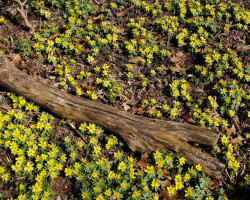
Winter aconite
Winter aconite (Eranthis) is an early-blooming spring groundcover that is perennial and ephemeral. It symbolizes hope, rebirth and new beginnings.
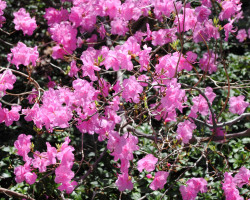
Rhododendron ‘Cornell Pink’
‘Cornell Pink’ (Rhododendron mucronulatum) is native to Asia. It is a dense, upright deciduous shrub that grows to a height and width of 4 to 8 feet.
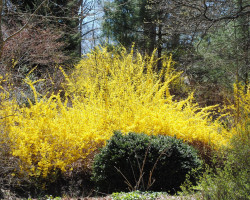
Forsythia
Forsythia – When winter finally ends, this deciduous shrub is ready to reenergize the early spring landscape with bright, lively hues. Forsythia is a genus of flowering plants in the olive family, Oleaceae.
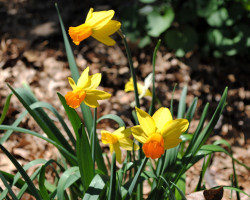
Daffodil
Daffodil (Narcissus) is a flowering perennial bulb in the amaryllis family. It gets its name from the Greek god Narcissus, who was so obsessed with his reflection in the water that he drowned attempting to capture it.
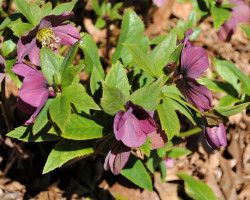
Lenten rose
Lenten rose (Helleborus orientalis) is a perennial flowering plant native to the Mediterranean. It is not a rose at all but a hellebore hybrid whose blooms are similar to a rose. The plants bloom in early spring, often during the season of Lent.
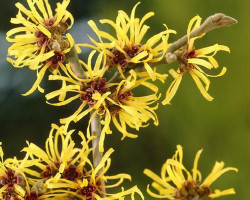
Witch hazel
Witch hazel (Hamamelis mollis) is a deciduous shrub that features showy, fragrant buttery, yellow strap-like flowers along its branches from late winter to early spring, before the leaves emerge. It typically matures to 10 to 15 feet tall with a rounded shape.
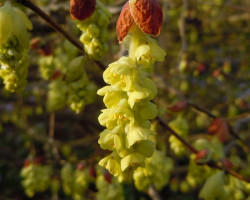
Chinese Witch hazel
Chinese Witch hazel (Corylopsis sinensis) is a deciduous shrub native to China. It has an upright, spreading, rounded shape and grows 10 to 15 feet tall. Nodding racemes of drooping, mildly fragrant, yellow flowers appear in early spring before the leaves emerge.
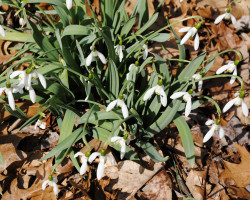
Snowdrop
Snowdrop (Galanthus nivalis) is a perennial bulb that is native to Europe and Asia. Galanthus is Greek for “milk,” while nivalis means “snow-like.” Snowdrops symbolize rebirth and the ability to overcome challenges in life.
April
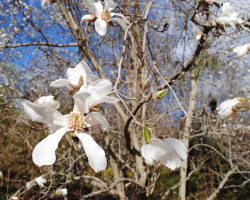
Magnolia kobus
Magnolia kobus (Magnolia kobus)
is a species of Magnolia native to Japan and Korea and occasionally cultivated in temperate areas. It is a deciduous, small to tall tree which has a slow rate of growth but can reach 49” tall.
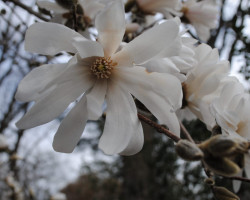
Star magnolia
Star magnolia (Magnolia stellata),
sometimes called the star magnolia, is a slow-growing shrub or small tree native to Japan. It bears large, showy white or pink flowers in early spring, before its leaves open.
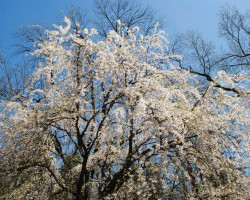
Yoshino cherry
Yoshino cherry (Prunus × yedoensis)
is regarded as one of the most spectacular flowering trees, for its thousands of showy, almond-scented blossoms in early spring. The Yoshino cherry is a fast growing, deciduous tree that can reach 40-50 ft.
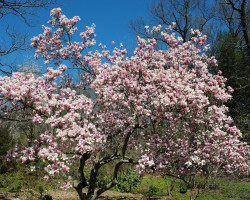
Saucer magnolia
Saucer magnolia (Magnolia X soulangeana)
is a very popular flowering tree or large shrub that was first cultivated in 1826.
It is a beautiful lawn tree with huge, saucer-shaped white blooms, pink on outside, on bare branches in late winter into early spring. Large leathery leaves, smooth gray bark, and yellow fall color add to the seasonal interest.
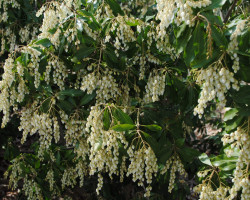
Andromeda Japonica
Andromeda Japonica (Pieris japonica)
is a slow-growing evergreen shrub to small tree that grows 9-13 feet tall in the heath family, Ericaceae. It is native to eastern Asia where it grows in mountain thickets. It features drooping clusters (racemes to 6 inches long) of lily-of-the-valley-like white flowers in early spring.
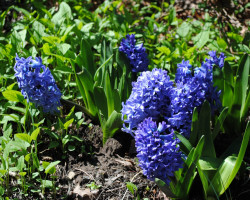
Hyacinth
Hyacinth (Hyacinthus orientalis)
is easy to grow from bulb to bloom. The beautiful spikes of flowers provide a strong, sweet fragrance. They are perennial bulbs and are often planted directly in the ground outdoors, though these easy bulbs are also excellent for forcing in container gardens or being made to flower indoors during the winter. They represent constancy and sincerity. The name is derived from the Greek word meaning purple. Hyakinthos (Hyacinthus) was a handsome young Spartan prince loved by the gods Apollon and Zephyros.
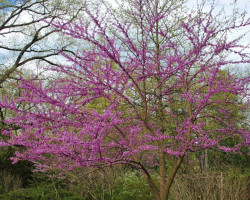
Eastern redbud
Eastern redbud (Cercis canadensis)
is a deciduous shrub or small understory tree, native to eastern North America, and blooms in a profusion of rosy pink flowers, which appear before its somewhat heart-shaped leaves of 2–6 inches. The blossoms are also edible and can add a bright, citrusy taste to salads. The unopened buds can also be pickled and used as a caper substitute.
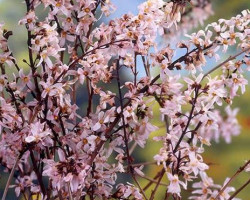
Pink forsythia
Pink forsythia (Abeliophyllum distichum Roseum)
– This deciduous, easy to grow, compact shrub is fragrant and related to the forsythia, but differs in that it has white rather than yellow flowers that open in early spring. It is a member of the olive family (Oleaceae). Because of its early flowering, forsythia stands for spring sun and anticipation.
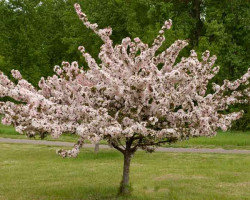
Crabapple
Crabapple (Malus)
is a genus of about 30–55 species of small deciduous trees or shrubs in the family Rosaceae, including the domesticated orchard apple – also known as the eating, cooking or culinary apple. The other species are commonly known as crabapples, crabtrees, or wild apples.
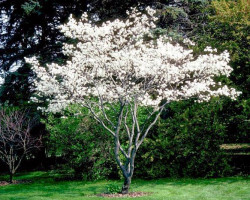
Shadblow
Shadblow (Amelanchier Canadensis)
is a Serviceberry, and one of the first native trees to bloom in the spring, when the shad are running in the rivers. They are large deciduous ornamental bushes or small trees. The fragrant flowers will appear before the leaves and attract many native, hungry, spring-flying pollinators. The flowers will give way to attractive dark purple berries, an important food source for many birds, and crescendos into brilliant fall leaves in shades of red and gold.
May
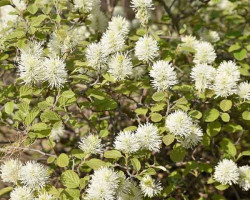
Witch alder
Witch alder (Fothergilla) is native to the southeastern U.S. This slow-growing deciduous shrub is admired for its fragrant, bottlebrush-like, white flowers in the spring; its leathery, blue-green summer foliage; and its spectacular fall leaf colors of yellow, orange and red-purple.
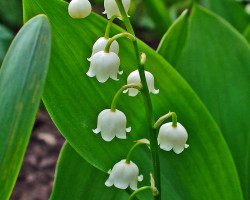
Lily of the valley
Lily of the valley (Convallaria majalis) is a moisture-loving perennial groundcover and one of the most fragrant woodland flowering plants with pendant, bell-shaped white flowers. Its origins are biblical; it’s a favorite of royal brides and is said to bring luck in love.
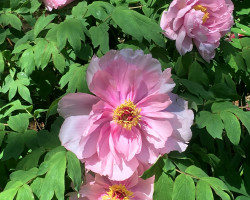
Tree peony
Tree peony (Paeonia suffruticosa) is a deciduous, woody shrub that typically grows 3’ to 5’ tall with a 4’ spread. The true species features large fragrant flowers 6” to 8” across and brittle stems with pink-to-white petals, each with a purple petal.
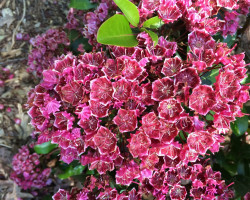
Mountain laurel
Mountain laurel (Kalmia latifolia) is commonly called calico bush or spoonwood. It is a gnarled, multistemmed, broadleaf evergreen shrub or small tree native to eastern North America. It is found in a variety of habitats including open rocky or sandy woods, cool meadow, bald mountain slopes and woodland margins. It is noted for its excellent spring flowers and attractive foliage year round. The Cherokee used the wood for carving.
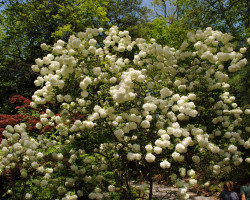
Chinese snowball
Chinese snowball (Viburnum macrocephalum) is a beautiful deciduous shrub or small tree with hydrangea-like flowers. With a rounded form and a semi-evergreen nature, this shrub blooms in the late spring with large, 8-inch white flowers that quickly turn green.
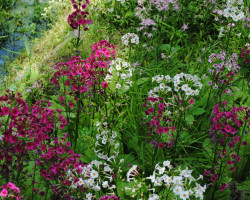
Japanese primrose
Japanese primrose (Primula japonica), this candelabra primrose is a robust and vigorous perennial that is considered to be the queen of primroses. A charming plant with attractive whorls of flowers in shades of white, pink, purple or red. These are spaced at intervals along upright stems and rise above basal rosettes of lettuce-like, bright green leaves.
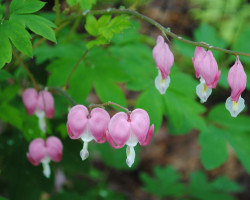
Bleeding heart
Bleeding heart [lamprocapnos (formerly dicentra) spectabilis] is an elegant, shade-loving perennial grown for its pendulous, puffy, heart-shaped spring flowers that dangle beneath their stems. It is ideally suited to cool, shady spots in the garden with moist soil, including in containers.
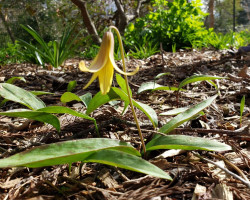
Trout lily
Trout lily (Erythronium) is a perennial, native to North America, that dwells in woodlands and has ephemeral flowers in the spring. Its gray-green leaves are mottled with brown and gray, resembling the coloring of brook trout.
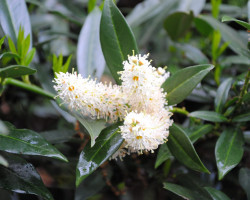
Cherry laurel “Otto Luyken”
Cherry laurel “Otto Luyken” (Prunus laurocerasus) is a dwarf form of Cherry laurel that is shade tolerant and ideal for small gardens. It is a compact, evergreen shrub that offers year-round interest with glossy dark green leaves and showy, fragrant, creamy white flower spikes that are followed by small black ornamental fruit. Its dense foliage provides winter shelter for birds. Excellent as a hedge, background plant or privacy screen.
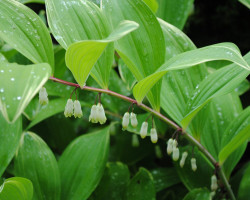
Solomon’s seal
Solomon’s seal (Polygonatum) is unsurpassed in grace. This is a shade-loving, rhizomatous perennial. Its slightly arching stems boast small clusters of two-to-six nodding, tubular creamy-white flowers tipped with green in late spring. The scars that remain where the leaves have dropped off resemble the 6th Seal of King Solomon for Protection Against All Earthly Dangers.
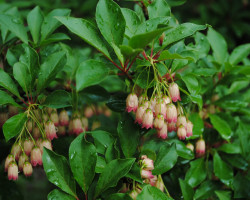
Redvein
Redvein (Enkianthus campanulatus) is an upright, deciduous shrub which typically grows 6’-to-8′ tall. It is native to open woodlands in Japan. Its bright green glossy foliage turns brilliant copper to red in autumn. In the spring, it has a profusion of bell-shaped, creamy white flowers with red veins.
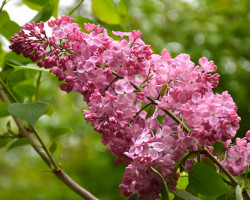
Hyacinth Lilac “Maiden Blush”
Hyacinth lilac or “Maiden’s Blush” (Syringia hyacinthiflora) is an upright, deciduous shrub that is low maintenance, exceptionally hardy and has an abundance of exquisitely scented, single pink flowers in mid-spring. The foliage often colors up to shades of red, purple and gold in the fall.
June
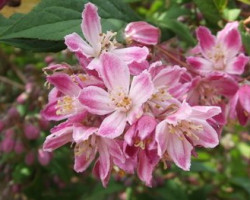
Deutzia x hybrid ‘Magicien’
Deutzia x hybrid ‘Magicien’ is a multi-stemmed deciduous shrub with an upright spreading growth habit . Its bell-shaped flowers are pink with white edging and appear in late spring in numerous racemes which cover the shrub for about two weeks. It should only be pruned after flowering to avoid removing any of the current season’s flowers. Genus name honors Johan van der Deutz (1743-1788), amateur botanist from Amsterdam.
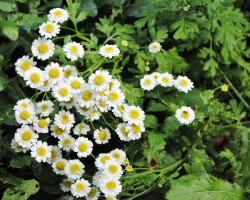
Feverfew
Feverfew (Tanacetum parthenium) is an aromatic, white, flowering plant in the daisy family, Asteraceae. Its name comes from the Latin febrifugia, meaning fever reducer. Feverfew is a medicinal herb commonly used to treat fevers, migraine headaches, rheumatoid arthritis, stomachaches, toothaches, insect bites, infertility, and problems with menstruation and labor during childbirth. Feverfew is a perennial, so cut it back to the ground after frost and watch for it regrow in the spring. It reseeds fairly easily, so you might find yourself giving away new plants within a couple of years.
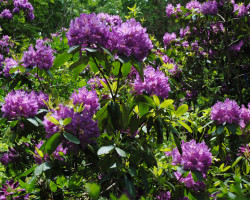
Rhododendron “Lees Dark Purple”
Rhododendron “Lees Dark Purple” is covered in clusters of deep purple trumpet-shaped flowers at the ends of the branches in mid-spring. The large narrow leaves remain green throughout the winter. It has a broad mounded habit, is quite hardy and does well in partial shade.
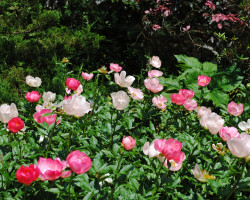
Herbaceous Peony
Herbaceous Peony (Paeonia lactiflora) is sometimes called Chinese or common peony. As a herbaceous perennial, this group of peonies produces annual stem growth during the spring and summer, only to die to the ground in late fall and remain dormant through the winter. The large fleshy root systems, crown and buds come to life again each spring to produce flowers. Herbaceous peonies are one of the most easily grown hardy perennials available today. Long lived and durable, a peony can easily live as long as 100 years.
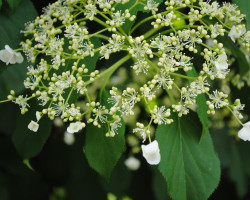
Climbing hydrangea
Climbing hydrangea (Hydrangea petiolaris) features large, fragrant clusters of white flowers that bloom in late spring and summer against a backdrop of dark green, heart-shaped foliage. These massive vines readily climb columns, trees, and other supporting structures. Without a supporting structure, climbing hydrangea plants form a mounding, arching shrub that grows to a height of 3 to 4 feet. It is slow to become established, but later spreads at a rapid pace.
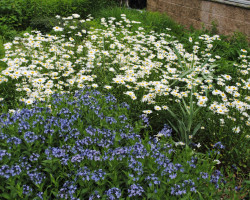
Bluestar
Bluestar (Amsonia hubrechti), Arkansas amsonia or Hubricht’s amsonia, is a perennial that is native to the Ouachita Mountains in central Arkansas. An erect, clump-forming plant, it is cultivated for its blue spring flowers, feathery green summer foliage and golden fall color. Powdery blue, half-inch star-like flowers appear in terminal clusters in late spring atop stems rising to 3 feet.
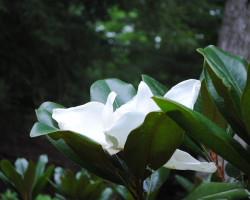
Magnolia grandiflora “Edith Bogue”
Magnolia grandiflora “Edith Bogue” is a glossy broadleaf evergreen tree that is noted for its attractive dark green leaves and its large white, extremely fragrant flowers. It typically grows to 60 to 80 feet with a pyramidal to rounded crown. The fragrant white flowers are 8 to 12 inches in diameter and usually have six petals. The fruit is an egg-shaped cone-like structure. Flowers bloom in late spring, with sparse continued flowering throughout the summer. It’s perhaps the hardiest of the southern magnolias and is native to moist wooded areas in the southeastern United States from North Carolina to Florida and Texas.
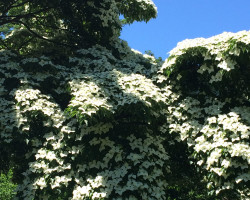
Japanese Dogwood
Japanese Dogwood (Cornus kousa) is a small deciduous flowering tree or multi-stemmed shrub with four seasons of interest. Spring brings a heavenly array of star-like blooms. These give way to pinkish-red fruit in summer, which persist into fall unless devoured by hungry birds. In the summer its canopy of layered branches, clad with oval, pointed, dark green leaves, provides shade and beauty. Fall offers spectacular bright red color when the foliage turns attractive shades of purple and scarlet. In winter, the exfoliating, mottled, tan and gray bark adds interest to the landscape.
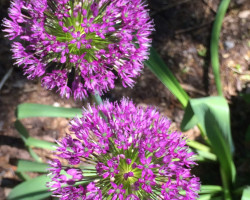
Allium
Allium is the scientific name for a genus of flowering plants that include hundreds of species, such as cultivated onion, garlic, scallion, shallot, leek, and chives. The exotic flower has brilliant purple blooms from spring into early summer. The perennial blubs return reliably every year, are pollinator favorites, and are deer-resistant.
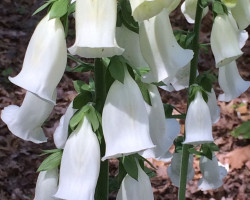
Foxglove
Foxglove (Digitalis) is a biennial, herbaceous plant that is native to Europe, western Asia, and northwestern Africa. Foxgloves provide vertical accents for areas of part sun or dappled shade. Bloom begins in late spring or early summer and continues for two or three weeks. The spires of tubular flowers attract hummingbirds and other pollinators.
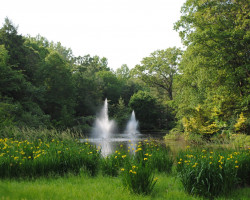
Yellow flag iris
Yellow flag iris (Iris pseudacorus) is a large yellow iris known as “yellow flag” or “yellow water iris” found in wetlands, along riverbanks and near ponds. It remains green during the winter where the weather is mild, but the leaves will die back during periods of prolonged drought or below-freezing temperatures. It spreads both by seed and by stout underground stems called rhizomes, from which its roots can grow to a foot in length. Native to Europe, Great Britain, North Africa and the Mediterranean region, it has been introduced in temperate areas worldwide and occurs throughout the United States except in the Rocky Mountains. The flowers are pollinated by bumblebees and long-tongued flies.
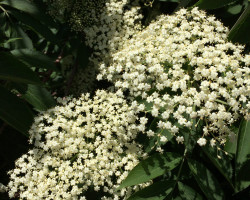
Elderberry
Elderberry (Sambucus Canadensis)–The American black elderberry, Canada elderberry, or common elderberry, is a species of elderberry native to a large area of North America east of the Rocky Mountains and south to Bolivia. It typically occurs on streambanks, moist woodlands, thickets, fence rows and roadsides. It grows in a variety of conditions including wet and dry soils, primarily in sunny locations. This spreading, multi-stemmed deciduous shrub has tiny lemon-scented white flowers that appear in large flat-topped clusters in June. The flowers give way to clusters of black elderberry fruits (drupes) in late summer. It is a good source of nectar for bees, butterflies, and other wildlife. The fruits of species plants are sometimes used to make jams, jellies, pie filings and elderberry wine.
Important note: Most parts of the elderberry plant can be toxic. The seeds, stems, leaves and roots of the Black Elder are all poisonous to humans. The fruit of the Black Elderberry should always be cooked before consumption.
July
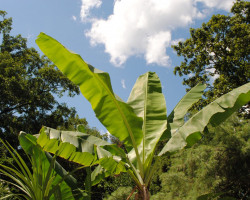
Ethiopian banana
Ethiopian banana (Ensete ventricosum), also known as Abyssinian banana, is a herbaceous species of flowering plant in the banana family Musaceae. It is available in traditional green or with a reddish tinge. Both plants grow large very quickly, making them a favorite landscaping plant. Once settled-in and happy, these plants truly are awesome. In our area, tropical plants such as these are considered to be annuals.
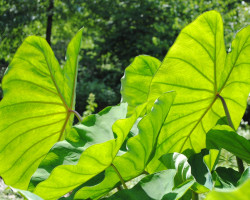
Elephant ears
Elephant ears (Colocasia) is a genus of flowering plants in the family Araceae, native to southeastern Asia and the Indian subcontinent. They are commonly grown for their large, tropical-looking foliage, which is reminiscent of elephant ears. They can be found in a variety of colors and sizes. Elephant ears can be used as background plants or edging, especially around ponds, along walkways, or in patio enclosures.
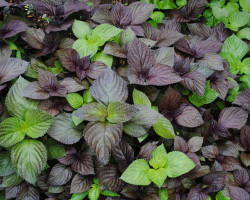
Perilla
Perilla (Perilla frutescens) or Korean perilla, is in the mint family Lamiaceae. An edible plant, perilla is grown in gardens and attracts butterflies. It is aromatic with a strong mint-like smell. This annual plant is native to Southeast Asia and Indian highlands, and is traditionally grown in the Korean peninsula, southern China, Japan and India as a crop.
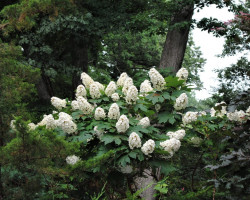
Hydrangea “Snow Queen”
Hydrangea “Snow Queen” (Quercifolia) is noted for its distinct, boldly lobed leaves and very showy blooms, “Snow Queen” is a deciduous shrub which provides a long season of interest. Named after the shape of its beautiful leaves, this Oak leaf hydrangea features dense, conical flower heads.
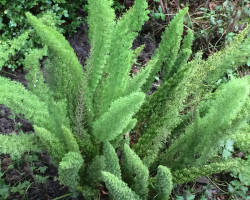
Foxtail fern
Foxtail fern (Asparagus aethiopicus) or Sprenger’s asparagus, is an unusual and attractive evergreen flowering plant that has many uses in the landscape. Although it is often used as an ornamental, it is considered to be invasive in many locations.
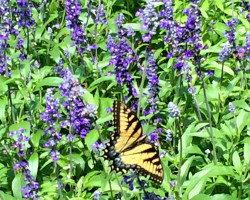
Salvia “Blue Victoria”
Salvia “Blue Victoria” is an herbaceous annual with an upright spreading habit of growth. Its medium texture blends into the garden but can always be balanced with finer or coarser plants for contrast.
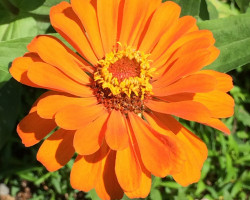
Zinnia
Zinnia is a genus of annuals of the sunflower tribe within the daisy family. The plants are native to scrub and dry grassland in an area stretching from the Southwestern United States to South America. Zinnias have bright, solitary, daisy-like flower heads on a single, erect stem, which makes them great cutting flowers or as food for butterflies. Zinnias symbolize endurance because they bloom from mid-summer all the way to frost.
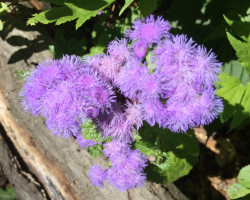
Ageratum “Blue Horizon”
Ageratum “Blue Horizon” (Ageratum houstonianum) is an annual and one of the tallest. “Blue Horizon” (Floss Flower) features fluffy round clusters of lavender-to-purplish-blue flowers resembling asters. This is a very vigorous plant with strong, sturdy stems, many branches and larger flowers than the traditional ageratum.
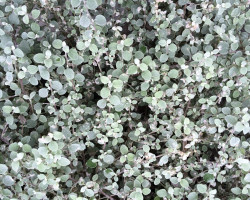
Licorice plant
Licorice plant (Helichrysum petiolare), bred for hot, sunny environments, is an evergreen shrub with soft, densely felted foliage. It lends interest to the border and has a slight licorice fragrance. The blooms consist of tiny white flowers that are insignificant.
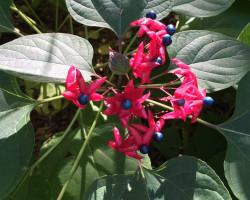
Clerodendrum
Harlequin glorybower (Clerodendrum trichotomum), also called a glorytree or peanut butter tree, is a species of flowering plant in the family Lamiaceae. It is native to China, Korea, Taiwan, Japan, India, and the Philippines. This large deciduous shrub, or small tree, is prized for its lovely fragrant flowers, autumn color, and ornamental berries. The leaves are ovate, up to 5 inches long, soft and downy or hairy, and produce a peanut odor when crushed.
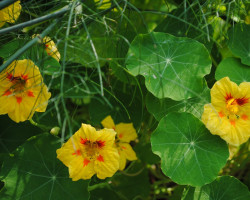
Nasturtium
Nasturtium (Tropaeolum), is a genus of roughly 80 species of annual and perennial herbaceous flowering plants. Native to South American countries, and brought to Europe in the 1500s, it was named by Carl Linnaeus in his book Species Plantarum. It is the only genus in the family Tropaeolaceae. Nasturtiums are cheerful, easy-to-grow annual flowers. Their bold blooms and edible leaves, flowers, and seedpods make them fun for children to plant and a favorite companion plant in the garden. Pests aren’t the only thing nasturtiums attract – their sweet nectar makes them a favorite of pollinators like bees, butterflies, and hummingbirds.
August
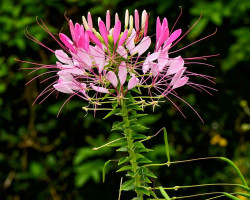
Spider flower
Spider flower (Cleome), a native of South America and the West Indies, began appearing in gardens in North America, Europe, and the UK in the early 1800s. It was a favorite annual of Victorian gardeners and a mainstay in that era’s cottage gardens. Growing cleomes is a simple and rewarding garden adventure. Planting is often necessary only once, as this attractive annual flower re-seeds prolifically and returns year after year. Seed pods may be removed before bursting for use in planting cleomes in other areas of the flower bed and garden.
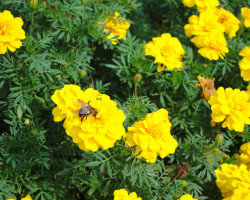
Marigold
Marigold (Tagetes) is a genus of annual or perennial mostly herbaceous plants in the sunflower family Asteraceae. Marigolds are native to the Americas, growing naturally from the southwestern United States into South America. Depending on the species, marigold foliage has a musky, pungent scent, though some varieties have been bred to be scentless. It is said to deter some common insect pests, as well as nematodes. Blooms naturally occur in golden, orange, yellow, and white colors, often with maroon highlights. In horticulture, they tend to be planted as annuals, although the perennial species are gaining popularity.
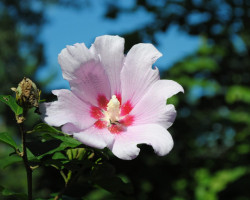
Rose of Sharon
Rose of Sharon (Hibiscus syriacus) is a species of flowering plant native to south-central and southeast China, and is cousin to Chinese hibiscus. What makes Rose of Sharon unique is that it can grow in much colder areas than tropical hibiscus. This hardy flowering perennial shrub has showy flowers that bloom from midsummer into fall, when most other shrubs are finished for the season. Rose of Sharon bushes are tolerant of a wide range of conditions, including poor soil, heat, humidity, drought and air pollution.
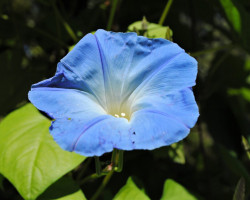
Morning glory
Morning glory is the common name for over 1,000 species of flowering plants in the family Convolvulaceae that have been popular for centuries. They were favorites for the cottage garden because they grow readily in poor soil and need little special care. The vines grow at a rapid pace and eventually produce trumpet-shaped flowers. There are several species of morning glory, each of which develops at a different time. Absence of flowers could mean the soil is too fertile, the plants aren’t sited correctly, or even that you have a late-blooming variety.
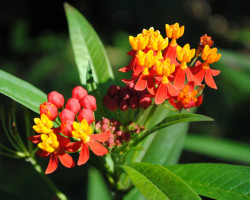
Tropical milkweed
Tropical milkweed (Asclepias curassavica) is an annual flowering plant species of the milkweed genus, Asclepias. It is native to the American tropics. Other common names include Mexican butterfly weed, blood flower, cotton bush, hierba de la cucaracha, redhead, scarlet milkweed, and wild ipecacuanha. The leaves are arranged oppositely on the stems, and like other members of the genus, the sap is milky. Tropical milkweed flowers in the summer. The flowers are in cymes with 10 to 20 flowers each. They have purple or red corollas and corona lobes that are yellow or orange.
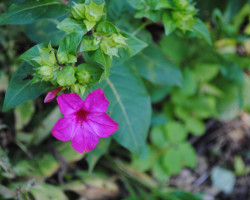
Four o’clock flower
Four o’clock flower (Mirabilis jalapa), or the marvel of Peru, is the most commonly grown ornamental species of Mirabilis plant, and is available in a range of colors. Four o’clock flowers are annuals and grow and bloom abundantly in the summer garden. Blooms open in the late afternoon and evening, hence the common name “four o’clocks.” Highly fragrant in a range of colors, the four o’clock plant sports attractive flowers that attract butterflies, bees, and hummingbirds. Grow four o’clocks in poor to average soil for the most abundant production of flowers.
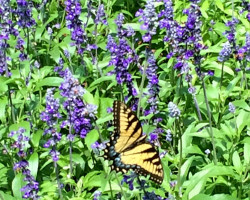
Butterfly bush
Butterfly bushes (Buddleia davidii) are grown for their long panicles of colorful flowers and their ability to attract butterflies and beneficial insects. They bloom in summer, but the naturally attractive shape of the foliage keeps the bush interesting, even when not in bloom. Butterfly bushes are perennial plants. They are native to provinces in central China, and also Japan.
Sept
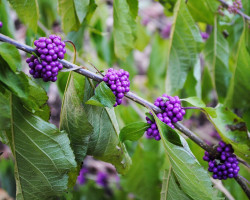
American beautyberry
American beautyberry (Callicarpa Americana) is a genus of shrubs and small trees in the family Lamiaceae. They are native to east and southeast Asia, Australia, Madagascar, southeast North America and South America. American Beautyberry most often grows 3 feet to 5 feet tall and usually just as wide. It can reach 9 feet in height in favorable soil and moisture conditions. It has long, arching branches and yellow-green fall foliage, but its most striking feature is the clusters of glossy, iridescent-purple (sometimes white) fruit which hug the branches at leaf axils in the fall and winter and look spectacular as the leaves drop in autumn.
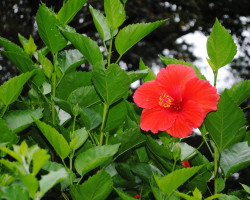
Hibiscus
Hibiscus is a genus of flowering plants in the mallow family, Malvaceae. The genus is quite large, comprising several hundred species that are native to warm temperate, subtropical and tropical regions throughout the world. Those that produce large, showy flowers are commonly known simply as hibiscus or rose mallow. Others include hardy hibiscus, rose of sharon and tropical hibiscus.
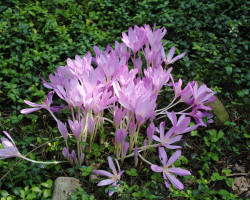
Autumn crocus
Autumn crocus (Colchicum autumnale) is also known as meadow saffron. The word crocus usually conjures images of cheerful small flowers emerging from snow and ice as the first harbinger of spring. But there are a few species of the genus Crocus, part of the iris family (Iridaceae), that bloom in the fall, as well as other fall-blooming bulbs that have the word crocus in their common name. In the U.S., the commonly called “Autumn Crocus” is not a true crocus at all but a species or hybrids of Colchicum, a group of fall-flowering bulb in the lily family (Lilaceae).
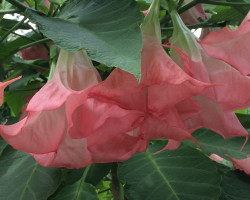
Angel’s trumpets
Angel’s trumpets (Brugmansia) is a genus of seven species of flowering plants in the family Solanaceae. They are woody trees or shrubs with pendulous flowers and have no spines on their fruit. Their large, fragrant flowers give them their common name of angel’s trumpets, a name sometimes used for the closely related genus Datura. The name refers to the large, pendulous, trumpet-shaped flowers, which come in shades of white, yellow, pink, orange, green, or red. They can reach heights of 10 feet to 36 feet. Flowers may be single, double, or more. Linnaeus first classified these plants as part of Datura with his 1753 description of “Datura arborea.” Then in 1805, C. H. Persoon transferred them into a separate genus, Brugmansia, named for Dutch naturalist Sebald Justinus Brugmans. For another 168 years, various authors placed them back and forth between the genera of Brugmansia and Datura, until in 1973, with his detailed comparison of morphological differences, T.E. Lockwood settled them as separate genus, where they have stayed unchallenged since.
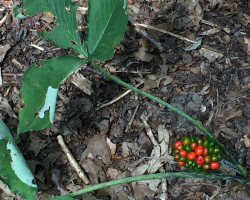
Jack-in-the-Pulpit
Jack-in-the-Pulpit (Arisaema triphyllum), known also as bog onion, brown dragon or Indian turnip, is a herbaceous perennial that grows from a corm. It is a highly variable species, typically growing 1 foot to 2 feet in height with three-part leaves and flowers contained in a spadix that is covered by a hood. One to two large, glossy leaves, divided into three leaflets, rise on their own stems 1 foot to 3 feet. The intriguing blossom of this woodland perennial occurs on a separate stalk at the same height as the leaves. It is a large, cylindrical, hooded flower, green in color with brown stripes. The distinctive “Jack-in-the-pulpit” formation grows beneath large leaves. In late summer, a cluster of bright red berries appears.
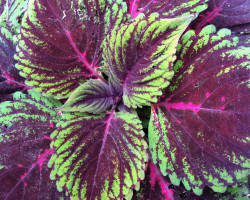
Coleus
Coleus (Coleus scutellarioides) is a species of flowering plant in the family Lamiaceae, native from southeast Asia to Australia. It is a perennial tropical that is not hardy except in warm, frost-free zones. Coleus is admired for its brightly colored foliage. It likes bright but indirect sunlight. If direct sunlight touches the leaves, the colors become less brightly colored. Outdoors, coleus needs total shade or only the most mild morning sunlight.
Photo credits – Lorraine Meyer

